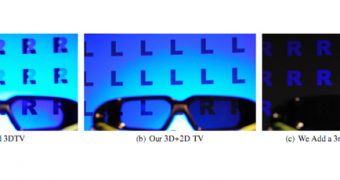The problem with most 3D TVs is that they ship with a limited number of pairs of glasses, which makes it hard to have movie nights after parties, unless you buy some extra pairs of glasses from somewhere.
And it's not like there's much space for a bunch of people to sit in front of a TV, unless you're rich and have a big house.
Besides, some people just don't like 3D, or have bad reactions for whatever reason, but would still like to enjoy a movie night with their loved ones.
Lo and behold, researchers at the University of California have found a solution: a “3D+2D TV.”
Which is to say, a television set that displays both 2D content and 3D content at the same time.
Those with 3D glasses see one thing, and those without see the movie, or whatever, in normal, 2D quality, instead of the double-image blurriness normal for such situations.
The TV is only a prototype for now, but it can successfully display a third feed, in addition to the two that show the 3D content.
Said third image is the negative of the right-eye image and has white spots, as opposed to the original that has black ones.
Similarly, where the original has red spots, the third image is blue; where the original is green, the third image is pink, etc.
It's all a sort of game to fool the human brain into thinking you're only seeing one set of images, because by negating the right-eye image, you're only left with the left-eye one.
Sadly, this approach does a really bad number on the image contrast, for both the 2D and 3D viewers.
More research might overcome this limitation eventually, but so far no dice, which is also why the technology won't be marketed any time soon.
A startup based on the 3D+2D TV technology might be established though, provided consumers continue to show interest in 3D content. While 3D films have been successful so far, that's mostly owed to them being more practical to run that way in cinemas. On the small screen, it's not nearly as immersive or awe-inspiring.

 14 DAY TRIAL //
14 DAY TRIAL //